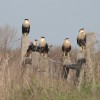 By Jim Stevenson
By Jim Stevenson
Folks, much has happened with the Galveston book and you need to know about it: The decision was made to morph it from a tabletop book to more of a typical book, with twice as many color plates and pages as the first draft. This will allow people to use it in the field easier, although the same two-page plates will still be there. The price is the same, $40. It goes to print tomorrow and I will begin mailing them as soon as they roll off the press. If you order, be SURE to gimme an address, and anything special you want written. Enjoy this article on Raptors.
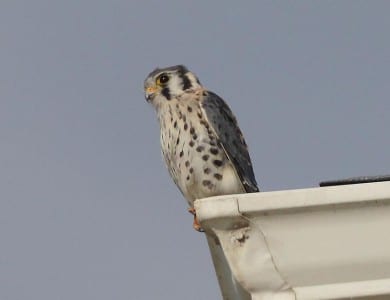
The order Falconiformes has long been the “large group” of birds of prey, with talons, hooked beaks and murderous natures. It included kites, hawks, harriers, buteos, eagles, accipiters, true falcons and a few oddballs like caracara and the Osprey. The nominate family of falcons, like the male kestrel above, has pointed wings and lightning-fast dives. And the kestrels are really the pussycats of the group!
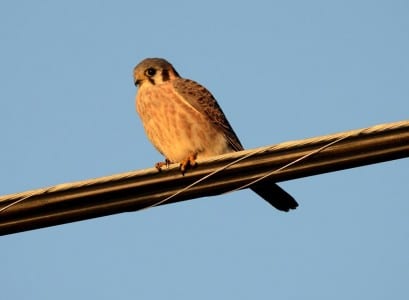
Sexual dimorphism is prevalent in the several kestrel species Worldwide, but pretty unusual with most raptors. This unit is a female American Kestrel, with the sun’s low light giving her a unusually reddish look. They are quite common fall through early spring in open land in the Deep South, and Galveston has them commonly on phone wires. That’s so you can telekestrel.
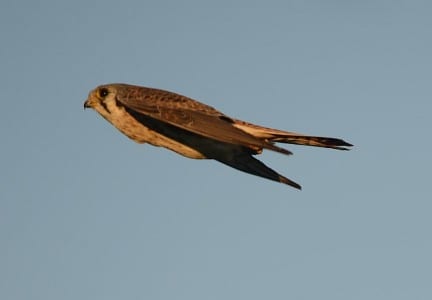
I walked toward her and she just laughed at the thought of an old man thinking he could gun her down on the wing. Boom. Notice the “helmet” look on the face of this and other falcons to come on this PDF. The long, tapered wings cut down on friction and allow them to fly at amazing speed. Falcons can also soar, but not as effectively as, say buteos.
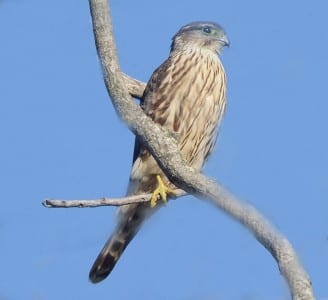
Merlins are lightning-fast little falcons that can take down small birds like, um, magic. I promise not to use the joke about Merlins changing from adult to juvenile plumage. The brown look is quite immature, in fact, and mortality is high for many hunters their first year. This species can be quite tame, as opposed to kestrels, which are infuriating to us photographers at times.
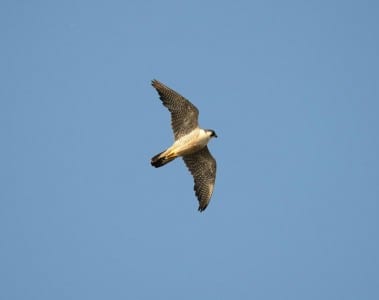
This adult Peregrine was playing “dive bomb” with an immature the other day, keeping fairly close to the water tower at the west end of the Island’s four-lane (where the rough-leg hung around late last winter). Notice the total barring, the pointed wings of a falcon and the helmet. This is the fastest animal on Earth, having dived at speeds nearing 200 mph (about what I drive on the Seawall).
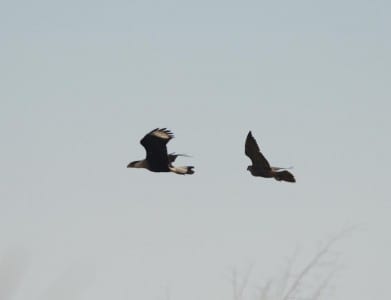
Suddenly the immature Peregrine broke off from his adult friend and tore after a passing caracara. The latter has been in the falcon family for decades, and is a very fast bird, but was totally outclassed by this aerial hunter. Note the full crop of the Peregrine. Of course, if the caracara turned abruptly and grabbed the falcon, even with relatively weak talons for a raptor, it could easily put the Peregrine out of his misery.
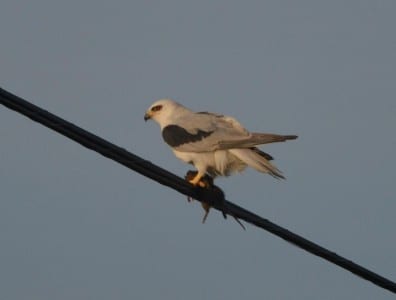
Kites are shaped rather like falcons, but fly much slower, hover a lot and dive bomb their prey feet first. These White-tailed Kites are common on the Texas Coast, extending down well into South America. There are also similar species in Africa and Australia. One of those is the Black-shouldered Kite, which was the old name of our bird. A huge portion of their diet here in Texas is the (Hispid) Cotton Rat, Sigmodon hispidus. That’s the wild version of the Black and Norway Rats that inhabit human structures, but cannot compete with S. hispidus in fields and such.
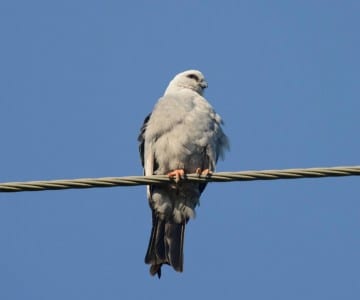
The Mississippi Kites clear out for the winter, heading to the Tropics where they join the very similar Plumbeous Kite. They are quite regular in oak forests between the coast and Houston, and over much of the Eastern 2-3rds of the Country where deciduous forests occur. They are late spring migrants and are common at the Hawkwatch Tower every day from late August to early October.
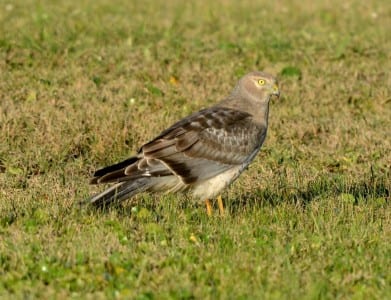
Harriers are like kestrels in that males and females have sexual dimorphism. However, young male harriers are still tinged with the brown of the juvenile plumage and many folks don’t realize the unstreaked brown ones are immatures which cannot be sexed in the field (a good way to get hurt). So, smart folks, how do you tell an immature harrier from an adult female, if they are both brown? Huh?
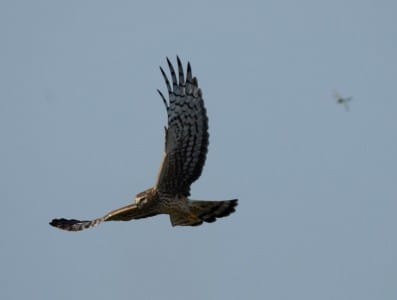
Here is the adult female harrier, with typical dihedral wing shape (like a Turkey Vulture), and you can easily see the heavily streaked underside. How odd it is that an adult hawk would be streaked below when the young are not! And how neat it is that this species nests in the grasslands of the State Park here, as well as next door to yours truly! Also notice the large dragonfly off to the right.
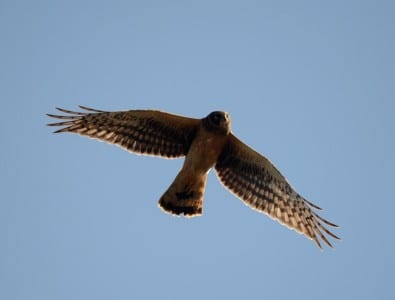
Now, in the middle of a down stroke, this immature harrier – sex unknown – sails over, wondering what that big guy in the Alaska cap is doing. I’m pretty sure it said, “God, I hope that’s a Canon and not a cannon.” But seriously, no streaking means a young bird, and the disk-shaped face allows harriers to pick up the sounds of scurrying rats in grass. BTW, no truth to the rumor that the AOU was going to place these in the class Mammalia because they were harrier. 😉 I find male harriers to be very interesting with their ventral spots. This genus of hawks (Circus) is slight, with thin legs and a small bill. They float along on tilted wings, and suddenly wheel and flop onto an unlucky Cotton Rat like the 2/3 of one you see. They are also quite wary of people and I count every harrier picture I take to be one of luck. I find it hairy getting close and even hairier getting their picture.
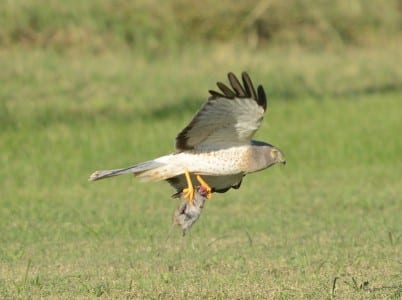
I sorely need a vacation.
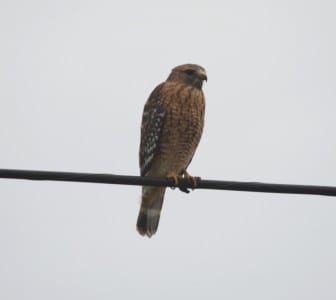
Buteos are heavier, soaring birds, and the Red-Shouldered Hawk is abundant all over the East. Curiously, they are almost never seen on Galveston, and are scarce on many islands. This adult – with reddish barring – is commonly seen on HW 36 north of the Municipal Speed Trap of Jones Creek, surely the most corrupt township this side of Afghanistan. Like about everywhere else, though, this species hunts rodents and (in the warm season) herps in the ditches.
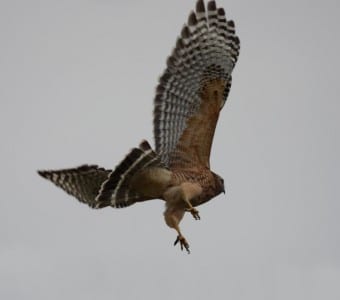
Taking off, you can see why they are named Buteo lineatus, or the “lined” hawk. They are even barred reddish underneath, like adult accipiters. I mean, they are barred about everywhere, including the leg feathers, the alula, undertail coverts and even those little gizmo feathers (better than gitmo) at the base of their primaries. Also notice the small bill and legs/feet, not the same strength of their cousin, the Red-tailed Hawk.
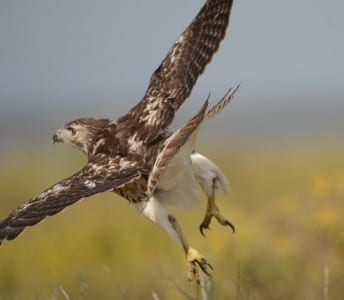
Here, let me run outside and get a similar red-tail shot. 😉 I honestly just took this one as well! But you can see the huge talons on stout legs and the heavy build of America’s most widespread raptor. The brown tail belongs to an immature, and not that many large hawks are brown on back. Interestingly, if you look hard, you can see the faint bands on the tail feathers and primaries. It seems they both have bands. And speaking of bands and bars: The convicts have a band; It’s bad as it can be; They’re familiar with the bars; But they can’t get the key.
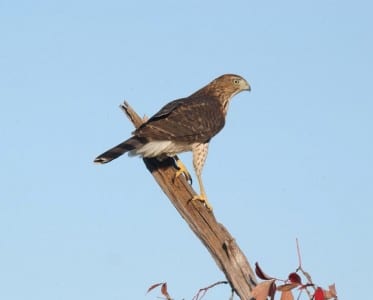
Accipiters are slender killers of warm-blooded animals, armed with short, rounded wings and lightning speed. The Cooper’s Hawk has about the dimensions of a Red-shouldered Hawk but in thinner. That doesn’t keep it from being about the most feared bird-eater on the Planet! I shot this with my friend Kevin Karlson, and we tagged a bunch of hawks that day! These accipiters get behind songbirds and match them move-for-move, finally overtaking them and having lunch.
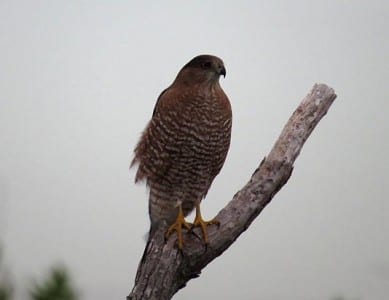
Sharp-shinned Hawks have a much smaller head and heavier markings on the chest. The reddish color is of the adult, not unlike the Red-shouldered Hawk I just showed you. I think sharpies may prefer more forested areas and Cooper’s more open sites, but there is probably a lot of overlap, too. You should see how fast one takes off! (Odd - that I have no recollection of taking this picture. Old age…)
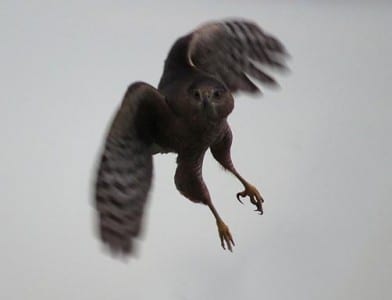
Vrrrooooommmmmm! Swoosh! YOU see how blurry the wings are? That tells you how fast they are flapped. But isn’t it cool how still the fuselage is? The bird is essentially dead still in the air, while the wings are doing all the work. That way she (probably, due to size) can keep her eyes on the prize. Sharp-shinned Hawk. (I don’t believe I took this picture but am trying hard to remember who might have sent it to me???)
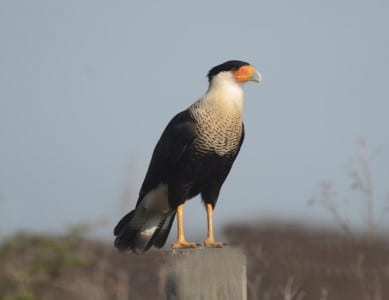
Formerly in the same family as falcons, the Crested Caracarais gradually getting more and more common in this area. The higher up the food chain the more slowly animal’s populations increase. Black ones like this are adults, and the orange cere (instead of yellow) indicates the bird is excited about something. Perhaps he’s waiting for me to tell a joke.
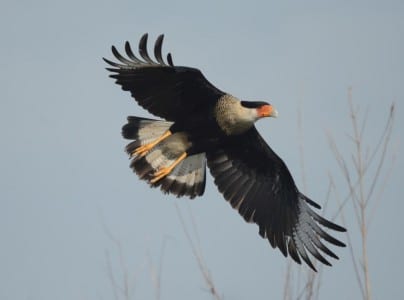
This adult is showing off his colors, and the primaries are an interesting study. Also, his retrices have gotten frail on the tip, probably due to its habit of walking on the ground. I don’t know; your thoughts? Thinking about the bands on the buteos we were noticing, I see they are subtle in the primaries and retrices in this bird, too.
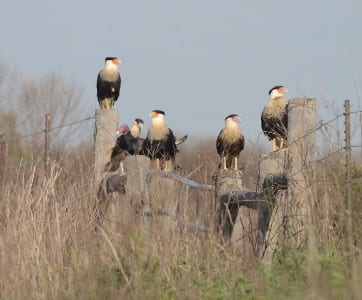
You can bet there’s a kill somewhere, with all these sarcophagus birds just hanging out together. Odd, though, as usually there’s one vulture mixing with a bunch of caracaras. Can you pick out the juvenile caracara? They are browner than the adults, as you might expect of raptors. But yes, good Janie Mae, it’s the one right above the Turkey Vulture.
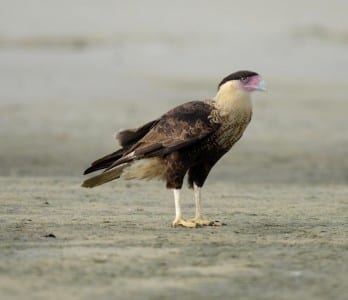
For fifteen years of living on this Island with caracaras, I never saw one on the beach. Now they have figured it out and forage for dead stuff washed in. And speaking of changes, this bird is coming of age, replacing his juvenile brown with the black of adults. The bare skin on the head is for sticking inside of a large animal’s viscera, avoiding the body nasties of the victim.
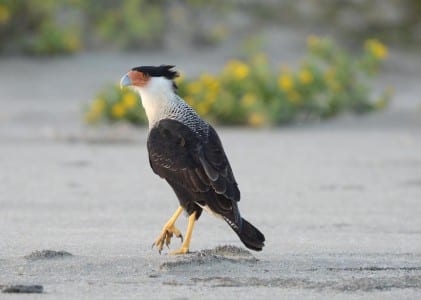
The smaller (but older) male is wondering why the younger bird is so tame, but see, he doesn’t realize I’m a former teacher. Most birds with crests can elevate them depending on their mood, and most crested birds are capable of strong mood expression, anyway. Notice how the feet are less like a hawk and more like a vulture? And the longer legs help in areas where you’re walking through rattlesnakes (which lift up off the ground). While the Eastern DB Rattler is more potent, the Western DBR’s habit of raising its head makes them overall a far more dangerous snake.
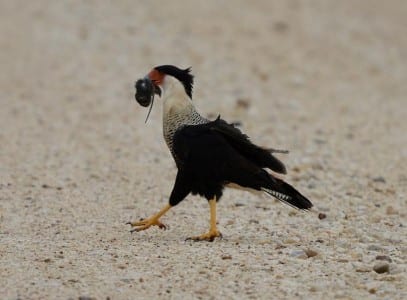
This is the first even recognizable photo I’ve gotten of a caracara on Galveston taking a rat, despite seeing them for over a decade, flying past my house with them in their beak. To me, watching an animal become adapted to a new environment is very exciting, and adds a lot more spice to birding than just ticking off species endlessly. There is so much to birding, and you might have some fresh, new insight to rock the World.
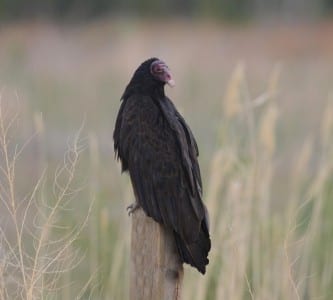
Notice how Turkey Vultures are more brown than black, (than Black V.), and they are also longer than their stubby, black friends. In the air, these are easily told by their long, tilted wings and less flapping than Blacks. But I am still struggling with the “dark” red head, wondering if TVs might be as prone to mood changes (in color) as caracaras. Inquiring minds want to know.

 Posted in
Posted in 























